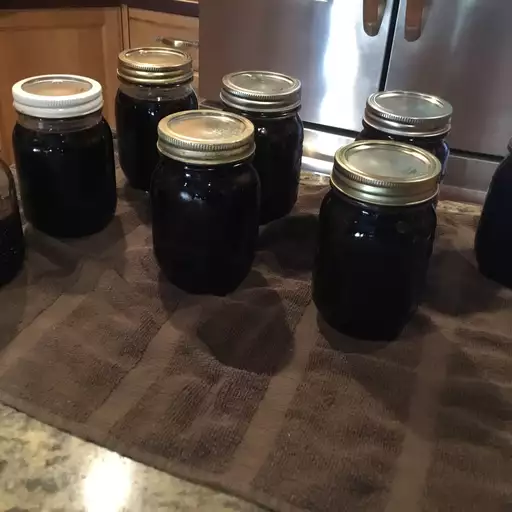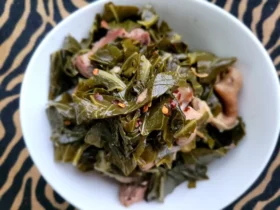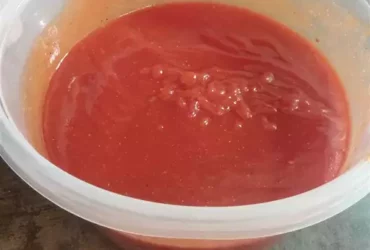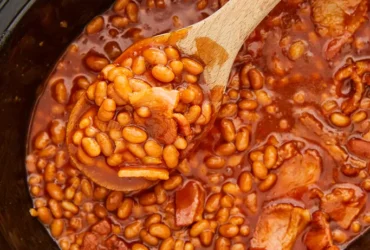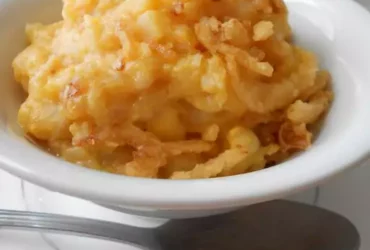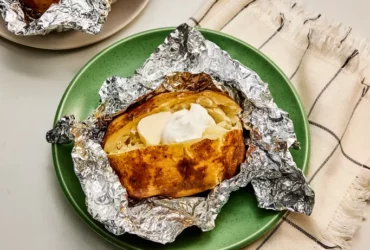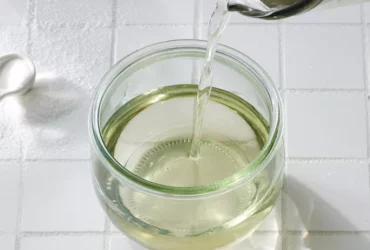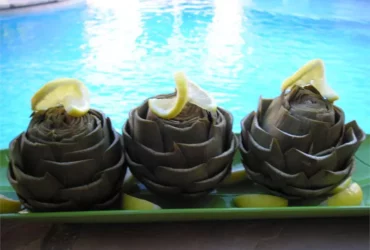Ingredients and Preparations
Syrop Ingredients
The ingredients for this Blackberry Syrup recipe are simple and can be found at most grocery stores.
To make a delicious blackberry syrup, you will need the following ingredients:
- 1 cup of fresh or frozen blackberries, depending on what is in season.
- 1 cup of granulated sugar.
- 1 cup of water.
- Optional: a few sprigs of fresh mint for added flavor and visual appeal.
For the preparation, follow these steps:
- In a medium-sized saucepan, combine the blackberries, sugar, and water. Make sure that the sugar is fully dissolved before proceeding to the next step.
- If you choose to use fresh mint, add it to the saucepan as well. The aroma of the mint will infuse into the syrup as it cooks.
- Bring the mixture to a boil, stirring occasionally, until the blackberries have broken down and the syrup has thickened slightly.
- Reduce heat to low and let simmer for 10-15 minutes or until the desired consistency is reached. You can test this by placing a small amount of the syrup on a chilled plate; if it holds its shape, it’s ready.
- Remove from heat and let cool slightly before sieving the syrup through a fine-mesh sieve into a clean container to remove any solids.
- Store in an airtight container in the refrigerator for up to 2 weeks or freeze for longer storage.
Blackberries (1 cup)
- To make blackberry syrup using fresh or frozen blackberries, you’ll need one cup of these fruits as a primary ingredient.
- Blackberries are rich in antioxidants and have a sweet-tart taste that pairs well with various flavors in cooking and baking.
- The sweetness level of the berries can vary depending on their ripeness and type; however, when using blackberries for syrup making, it’s generally best to choose ripe fruits for the optimal flavor balance.
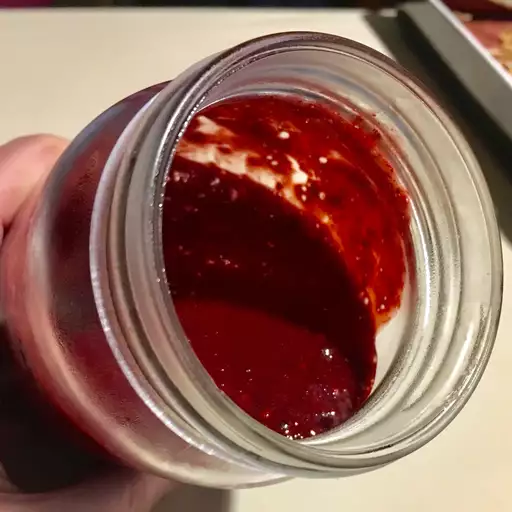
Here are some tips for preparing fresh blackberries:
Pick or purchase ripe blackberries. Ensure they’re free of mold and have a slight sheen on their surface.
Wash the berries in cold water, gently agitating them to release any dirt or debris.
Gently pat dry the blackberries with paper towels or clean cloth to remove excess moisture. This step helps prevent an excessively runny syrup during cooking.
Next, combine the prepared blackberries with a sweetener of your choice (such as sugar, honey, or maple syrup) in a saucepan over medium heat. The amount of sweetener needed will depend on the desired level of sweetness and whether you’re using fresh or frozen berries.
Cooking the mixture while stirring occasionally will allow the flavors to meld together and help break down the cell structure of the blackberries, releasing their natural juices.
Granulated sugar (1 cup)
Granulated sugar, a fundamental ingredient in many sweet recipes, including our Blackberry Syrup recipe.
The purpose of granulated sugar in this recipe is to balance out the tartness of the blackberries and create a smooth, velvety syrup.
Choosing the Right Granulated Sugar
- We recommend using a high-quality granulated sugar that has been processed from pure cane or beets for optimal flavor.
- Some popular brands include Domino, C&H, and Baker’s Pride.
- Avoid using sugar that is labeled as “baker’s sugar” or “superfine sugar,” as these products have a finer texture and may not dissolve evenly in the syrup.
Measuring Granulated Sugar
- Weigh out 1 cup of granulated sugar, using a digital kitchen scale for accurate measurements.
- For an approximate measurement, you can also use a dry measuring cup to scoop the sugar into a bowl.
Cleaning and Preparation
Before adding the granulated sugar to the recipe, make sure your equipment is clean and sanitized.
This includes washing your hands thoroughly with soap and water, as well as cleaning any utensils or containers that will come into contact with the sugar.
Storage
Avoid exposing granulated sugar to air, moisture, or heat, as this can cause it to become clumpy or develop off-flavors.
Store your granulated sugar in an airtight container at room temperature (about 70°F to 75°F or 21°C to 24°C).
Tips and Variations
- If you prefer a lighter syrup, use less granulated sugar and adjust the recipe accordingly.
- For a darker syrup with more molasses flavor, add a small amount of brown sugar to the recipe.
Now that we have covered the basics of using granulated sugar in our Blackberry Syrup recipe, you can confidently create your own batch and enjoy its rich, sweet flavor!
Water (2 cups)
Cups of water are a crucial ingredient for the preparation of Blackberry Syrup, as they help to create a perfect balance between the sweetness of the blackberries and the desired consistency of the syrup. In total, we will need 2 cups of water for this recipe.
Preparation Instructions
- Add 1 cup of water to a medium saucepan and place it on the stovetop over medium heat.
- While the water is heating up, prepare your blackberries. Rinse them in cold water, remove any stems or debris, and then cut them in half to release their natural juices.
- Once the water has reached a gentle simmer, add the remaining cup of water and the prepared blackberries to the saucepan.
- Cook for about 15-20 minutes, stirring occasionally, until the blackberries have broken down and the mixture has thickened into a syrup-like consistency. You can help this process along by mashing some of the berries with a spoon or by using an immersion blender.
Final Touches
- Remove the saucepan from the heat and let it cool slightly.
- Strain the Blackberry Syrup into a clean glass jar or container through a fine-mesh sieve to remove any remaining seeds or pulp. Discard the solids.
- Store the syrup in an airtight container in the refrigerator for up to 2 weeks. You can also freeze it for longer-term storage by transferring it to an ice cube tray and then storing the frozen cubes in a zip-top bag.
This simple process will result in a delicious homemade Blackberry Syrup that is perfect for topping pancakes, waffles, or even yogurt parfaits. Enjoy experimenting with different flavor combinations, like adding a splash of lemon juice or a pinch of cinnamon to create unique variations!
Lemon juice (1 tablespoon)
Lemon juice is added to the blackberry syrup recipe as a flavor enhancer and preservative. The acidity in the lemon juice helps to balance out the sweetness of the blackberries, while also creating an environment that inhibits the growth of bacteria and mold.
For this recipe, you will need 1 tablespoon of freshly squeezed lemon juice. This is a relatively small amount, as the goal is to enhance the flavor without overpowering it with citrus.
When preparing the lemon juice for use in the blackberry syrup recipe, make sure to extract the juice from fresh lemons using a manual or electric juicer. Be careful not to include any seeds or pulp in the juice, as these can give the final product an unpleasant texture.
The acidity of the lemon juice will start to break down immediately upon contact with the other ingredients, so it’s essential to add it to the mixture just before combining all the components. This ensures that the flavors are evenly distributed throughout the blackberry syrup and prevents any separation or sedimentation during storage.
Puree Preparation
The key to making a delicious blackberry syrup lies in the quality of the ingredients used for puree preparation. For this recipe, you will need:
1 cup fresh or frozen blackberries – If using frozen, make sure to thaw them first and pat dry with a paper towel to remove excess moisture.
2 tablespoons granulated sugar
1 tablespoon water (optional)
A blender or food processor for pureeing the blackberries
A fine-mesh sieve or cheesecloth for straining the puree
Optional: a lemon wedge or juice for added flavor and preservation
Now, let’s move on to the steps involved in preparing the puree:
- Rinse the blackberries under cold running water and pat them dry with paper towels. If using fresh berries, remove any stems or debris.
- Add the blackberries to a blender or food processor with 2 tablespoons of granulated sugar and 1 tablespoon of water (if using). Blend until smooth.
- Strain the puree through a fine-mesh sieve or cheesecloth into a bowl, pressing on the solids to extract as much juice as possible. Discard the solids.
- If desired, add a squeeze of lemon juice (about 1/2 teaspoon) and mix well. This will help preserve the syrup and enhance its flavor.
Now that we have prepared the blackberry puree, we are ready to proceed with making the blackberry syrup!
Rinse blackberries in a finemesh sieve under cold running water, pat dry with paper towels. Remove the stems and mash or puree in a blender until smooth.
The first step in preparing blackberries for this syrup recipe involves thoroughly cleaning and drying them to remove any dirt, debris, or excess moisture that may affect the flavor or texture of the final product.
Rinse the blackberries under cold running water in a fine-mesh sieve. This helps to wash away any dirt, pesticides, or other impurities that might be present on the fruit’s surface. The cold water also prevents the berries from becoming mushy or breaking down prematurely.
Pat dry the rinsed blackberries with paper towels. This is an essential step in removing excess moisture from the blackberries, which will help prevent bacterial growth and spoilage during storage. It also aids in achieving a clearer syrup by reducing the likelihood of mold or yeast growth.
To release the flavor and juices from the blackberries, you’ll need to remove their stems and mash or puree them until smooth. This can be done using a potato masher or a blender with a high-powered motor, such as an immersion blender.
Mashing or blending will break down the cell walls of the blackberries, allowing you to extract their natural sweetness and flavor. The resulting puree should be smooth and uniform, with no visible chunks or seeds remaining. This is essential for achieving a clear and consistent syrup in the end.
By following these steps carefully, you can ensure that your blackberries are properly prepared for making a delicious homemade blackberry syrup. The result will be a rich, flavorful condiment perfect for topping ice cream, yogurt, or pancakes, as well as using in baking recipes or as a glaze for meats and cheeses.
Preserving Methods
Sterilization Options
The preservation methods for making blackberry syrup involve several steps to ensure that the final product remains safe and nutritious throughout its shelf life. Here are some of the common preservation methods used for making blackberry syrup:
Sterilization: Sterilizing equipment and utensils is crucial in preventing contamination during the process of making blackberry syrup. The use of steam sterilizers or autoclaves can be effective in achieving this goal.
Pasteurization: Pasteurization involves heating the blackberries to a temperature of 160°F (71°C) for 15 seconds, followed by rapid cooling. This method is effective in killing off bacteria and other microorganisms that may be present in the blackberries.
Canning: Canning involves filling hot syrup into sterilized jars or containers, leaving a small headspace, and then sealing them with tight-fitting lids. The sealed jars are then submerged in boiling water for 10-15 minutes to kill off any bacteria that may be present.
Dehydration: Dehydrating blackberries involves removing the moisture from the fruit by using methods such as freeze-drying or air drying. This method is effective in preserving the flavor and nutrients of the blackberries, but it may not be suitable for making syrup.
Freeze-drying: Freeze-drying involves freezing the blackberries and then removing the moisture from them under vacuum conditions. This method is effective in preserving the flavor and nutrients of the blackberries, but it may not be suitable for making syrup.
When it comes to sterilization options, there are several methods that can be used to ensure that the equipment and utensils are free from contamination. These include:
Steam Sterilizers: Steam sterilizers use steam to kill off bacteria and other microorganisms on surfaces. They are effective in achieving high temperatures of up to 270°F (130°C).
Autoclaves: Autoclaves use high-pressure steam to achieve high temperatures of up to 250°F (121°C). They are commonly used for sterilizing equipment and utensils in laboratories.
Hot Water Bath: A hot water bath is a simple method that involves submerging the equipment and utensils in boiling water for 10-15 minutes. This method is effective in killing off bacteria that may be present on surfaces.
Ethylene Oxide Sterilization: Ethylene oxide sterilization involves using ethylene oxide gas to kill off bacteria and other microorganisms on surfaces. This method is commonly used for sterilizing equipment and utensils in healthcare settings.
When choosing a preservation method, it’s essential to consider the type of blackberry syrup you’re making and the equipment and utensils you have available. Different methods may be more suitable than others depending on your needs.
It’s also essential to follow proper food safety guidelines when making blackberry syrup. This includes using clean equipment and utensils, storing the syrup in airtight containers, and refrigerating it at a temperature of 40°F (4°C) or below.
Sterilize your syrup using either boiling water bath canning method for 10 minutes (USDA) at 212°F (100°C), or by using an autoclave process to kill off any bacteria according to standard procedures from the National Institute of Standards and Technology.
The final step in preserving blackberry syrup involves sterilizing the product to eliminate any remaining bacteria that may have been introduced during the cooking process. This can be accomplished using either the boiling water bath canning method or by employing an autoclave process.
For those who prefer a more traditional approach, the boiling water bath canning method is recommended for its simplicity and effectiveness. To do this, place clean glass jars filled with the blackberry syrup into a large pot of boiling water, making sure that they are completely submerged. The pot should be deep enough to allow at least 1 inch (2.5 cm) of water above the tops of the jars.
Next, bring the water to a boil and maintain it for exactly 10 minutes according to USDA guidelines. It’s essential to monitor the time carefully and not exceed this duration, as overprocessing can result in a loss of flavor and texture. The syrup will be adequately sterilized at this stage, killing off any bacteria that may have been present.
On the other hand, those who prefer more advanced technology or require precise control over temperature and pressure can opt for an autoclave process. An autoclave is essentially a pressurized chamber designed to subject materials to high temperatures and pressures under controlled conditions. This method follows standard procedures outlined by the National Institute of Standards and Technology (NIST).
When using an autoclave, it’s crucial to adhere strictly to NIST guidelines to ensure accurate results. Generally, this involves heating the syrup to a minimum temperature of 212°F (100°C) for a specified duration while maintaining high pressure within the chamber.
The choice between these two methods depends largely on personal preference and specific circumstances. However, both boiling water bath canning and autoclave processing are effective means of sterilizing blackberry syrup and ensuring its shelf life remains extended over time.
Storage Methods
To preserve blackberry syrup, several methods can be employed to extend its shelf life and maintain its quality.
Refrigeration is a common method for storing perishable liquids like blackberry syrup. When refrigerated at a temperature of 40°F (4°C) or below, the syrup’s growth of bacteria and mold is slowed down significantly. It is essential to store the syrup in a clean, tightly sealed container to prevent contamination.
Canning is another effective method for preserving blackberry syrup. This process involves filling sterilized jars with hot syrup, sealing them, and then processing them in a boiling water bath for 10 minutes. After canning, the jars are left to cool before being stored in a cool, dark place.
Dry ice freezing is a method used to preserve blackberry syrup for short-term storage. This process involves mixing dry ice with the syrup and then placing it in an insulated container. The mixture will freeze rapidly, preserving the syrup’s flavor and texture.
Freezing is another popular method for storing blackberry syrup. This can be done by pouring the syrup into airtight containers or freezer bags and then placing them in the freezer. When frozen, the syrup will remain safe to consume for several months. It’s crucial to label the containers with the date and contents to ensure proper identification.
Sugar concentration is an effective way to preserve blackberry syrup by creating a less hospitable environment for microorganisms to grow. By increasing the sugar content of the syrup, it becomes more difficult for bacteria and mold to thrive. However, this method should be used in conjunction with other preservation methods, such as refrigeration or canning, to ensure the syrup remains safe to consume.
It’s essential to note that each preservation method has its unique benefits and drawbacks. For instance, refrigeration is a convenient method but may not preserve the syrup indefinitely. Canning, on the other hand, provides long-term storage capabilities but requires specialized equipment and techniques. By understanding the different preservation methods available, individuals can choose the best approach for their specific needs and ensure that their blackberry syrup remains safe to consume for an extended period.
Store your blackberry syrup in airtight glass bottles away from direct sunlight. Refrigerate for up to six months to preserve flavor.
To maintain the quality and freshness of your homemade blackberry syrup, it’s essential to store it properly. Start by transferring the syrup to airtight glass bottles, such as Mason jars or similar containers with tight-fitting lids.
Avoid using plastic containers or bottles with screw-top lids, as they may allow oxygen to seep in and affect the flavor of the syrup. Glass bottles are ideal because they are non-reactive and will not impart any flavors or odors to the blackberry syrup.
Next, store the glass bottles containing the blackberry syrup away from direct sunlight. Sunlight can cause the syrup to degrade, leading to a loss of flavor, color, and nutritional value. Place the bottles in a dark cabinet, pantry, or cupboard where they will be protected from light exposure.
When it comes to storing the blackberry syrup in the refrigerator, make sure the storage area is at a consistent temperature between 39°F and 41°F (4°C and 5°C). This will help slow down the spoilage process and prevent the growth of bacteria or mold. Label each bottle with the date you stored it and keep track of the number of months it has been in the refrigerator.
As mentioned earlier, blackberry syrup can be refrigerated for up to six months. However, if you notice any signs of spoilage, such as off odors, slimy texture, or mold growth, discard the syrup immediately and make a fresh batch. Proper storage will help maintain the flavor, aroma, and nutritional benefits of your homemade blackberry syrup.
- Best Dun & Bradstreet (DNB) Alternatives for 2025 - April 24, 2025
- Best Seamless.ai Alternatives for 2025 - April 22, 2025
- Best Coldlytics Alternatives for 2025 - April 22, 2025

